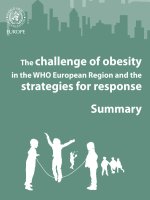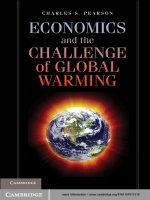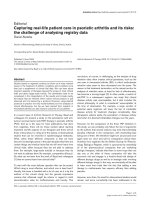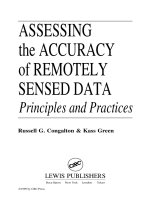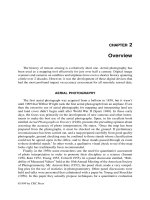International bussiness the challenge of global competition 11e chapter 04
Bạn đang xem bản rút gọn của tài liệu. Xem và tải ngay bản đầy đủ của tài liệu tại đây (896.03 KB, 35 trang )
chapter four
International Institutions from an
International Business
Perspective
McGraw-Hill/Irwin
International Business, 11/e
Copyright © 2008 The McGraw-Hill Companies, Inc. All rights reserved.
Learning Objectives
Describe the influence the mainly political international
institutions have on international businesses and their
relevance to international business
Identify the major organs of the United Nations, their
general purpose, and their significance to international
business
Discuss the World Trade Organization and its
predecessor, GATT
Appreciate the resources of the Organisation for
Economic Cooperation and Development
4-3
Learning Objectives
Describe the major purpose and effectiveness of
OPEC
Identify economic integration agreements and the
effectiveness of the major ones
Discuss the impact of the EU and its future
challenges
4-4
Figure 4.1 International Institutions by
purpose
4-5
International Political Institutions
• The United Nations
– International organization of 191 member-nations
dedicated to the promotion of peace and global
stability; has many functions related to business
– General Assembly
• Deliberative body of the UN made up of
all member-nations, each with one vote
regardless of size, wealth, or power
4-6
International Political Institutions
– Security Council
• Main policy-setting body of the UN,
composed of 15 members including 5
permanent members
– Economic and Social Council (ECOSOC)
• UN body concerned with economic and
social issues such as trade, development,
education, and human rights
4-7
International Political Institutions
– International Court of Justice (ICJ)
• UN body that renders legal decisions
involving disputes between national
governments
– Secretariat
• The staff of the UN, headed by the
secretary-general
4-8
Figure 4.2 Millennium Development
Goals Chart of Progress
4-9
Figure 4.2 Millennium Development
Goals Chart of Progress
4-10
Cooperative Military and Security
Agreements
• North Atlantic Treaty Organization (NATO)
– Security alliance of 26 North American and
European nations (Map 4.3)
• Collective Security Treaty Organization (CSTO)
– Security alliance of six members of the
Commonwealth of Independent States (former
Union of Soviet Socialist Republics)
4-11
Cooperative Military and Security
Agreements
• Association of Southeast Asian Nations (ASEAN)
– Ten-member body formed to promote peace and
cooperation in Southeast Asia
(Map 4.4)
4-12
Map 4.3 & 4.4
NATO Map
Map of ASEAN Members
4-13
International Economic Institutions
• World Trade Organization (WTO)
– A multinational body of 149 members that deals
with rules of trade between nations
– Outgrowth of General Agreement on Tariffs and
Trade (GATT), that functioned to encourage trade
liberalization from 1947 to 1995
4-14
International Economic Institutions
• Most favored nation (MFN) clause
– Agreement that GATT member-nations
would treat all members equally in trade
matters
• Uruguay Round
– The last extended conference of GATT
negotiations (table 4.1)
4-15
Table 4.1 Gatt Rounds
4-16
International Economic Institutions
• WTO Principles
– Trade will be without discrimination
– Trade should be freer, with trade barriers negotiated
downward
– Trade should be predictable
– Trade should be more competitive
– Trade should be more beneficial for less developed
countries, encouraging development and economic
reform
4-17
International Economic Institutions
• WTO Challenges
– Trade-related intellectual property rights (TRIPS)
• WTO agreement that protects copyrights,
trademarks, trade secrets, and other
intellectual property matters
4-18
Organisation For Economic
Cooperation and Development
• Organisation For Economic Cooperation and
Development (OECD)
– Group of developed countries dedicated to
promoting economic expansion in its membernations (Table 4.2)
4-19
Table 4.2 OECD Member Countries
4-20
Other Economic Institutions
• Organization of Petroleum Exporting Countries
– Cartel of 11 petroleum exporting countries (Table
4.3)
• The Group of Eight (G8)
– Group of government leaders from major
industrialized nations that meets regularly to
discuss issues of concern (Figure 4.5)
4-21
Table 4.3 World Petroleum Products
Consumption by Region, 1960-2004
4-22
Figure 4.5 The G8 Members
(www.undp.org)
/>
4-23
Economic Integration
• Free trade area (FTA)
– Area in which tariffs among members have been
eliminated, but members keep their external tariffs
• Customs Union
– Collaboration that adds common external tariffs to
an FTA
• Common Market
– Customs union that includes mobility of services,
people, and capital within the union
4-24
North American Free Trade Agreement
(NAFTA)
• NAFTA
– Established January 1, 1994
– Agreement creating a free trade area among
Canada, Mexico, and the United States
4-25
